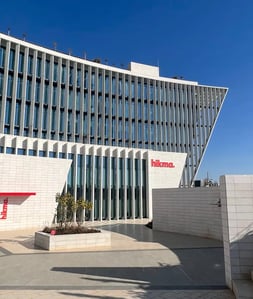HUTCHMED (China) Limited (Nasdaq/LON:HCM; HKEX: 13) has announced key research and development (R&D) and business updates presented during its R&D Updates event held on October 31, 2025. The event highlighted HUTCHMED’s progress in advancing innovative cancer and immunology treatments, including the introduction of its next-generation Antibody-Targeted Therapy Conjugate (“ATTC”) platform, alongside updates on late-stage pipeline candidates.
“Our commitment to advancing innovative therapies drives HUTCHMED’s mission to address critical unmet needs in oncology and immunology,” said Dr. Michael Shi, Head of R&D and Chief Medical Officer of HUTCHMED. “The ATTC platform’s potential to redefine precision oncology, combined with our robust pipeline and partnership strategy, positions us to deliver potentially transformative cancer and immunology treatments to patients around the world.”
Breakthrough ATTC Platform and Lead Candidate HMPL-A251
The ATTC platform represents potentially a groundbreaking approach to precision oncology, integrating monoclonal antibodies with proprietary small-molecule inhibitor payloads to deliver dual mechanisms of action. The ATTC platform integrates monoclonal antibodies with proprietary small-molecule inhibitor payloads to deliver dual mechanisms of action. In contrast to traditional cytotoxin-based antibody-drug conjugates (“ADC”), ATTCs leverage targeted therapies to achieve synergistic anti-tumor activity and durable responses, as demonstrated in preclinical models. These conjugates have shown superior efficacy and safety profiles compared to standalone antibody or small molecule inhibitor components.
Overcoming Cancer Challenges with PAM-Targeting Payload: The first wave of ATTC candidates focuses on payloads targeting the PI3K/AKT/mTOR (“PAM”) signaling pathway. The PAM pathway is a critical intracellular network involved in cell growth, survival, and division. Alterations in the PAM pathway are frequently associated with poor prognosis and resistance to treatment across various cancers. However, existing PAM-targeted drugs face significant limitations, including on-target toxicities that restrict dosing, feedback loops that enable pathway reactivation, and insufficient tumor-specific delivery. The ATTC strategy tries to address these challenges by enhancing targeted delivery of PAM inhibitors directly to tumor cells, maximizing therapeutic benefit while minimizing systemic exposure.
HUTCHMED’s Lead ATTC Candidate, HMPL-A251: HMPL-A251 is a PAM-HER2 ATTC consisting of a highly selective and potent PI3K/PIKK inhibitor payload conjugated to a humanized anti-HER2 IgG1 antibody via a cleavable linker. Preclinical data for HMPL-A251 was recently presented at the 2025 AACR-NCI-EORTC International Conference on Molecular Targets and Cancer Therapeutics. In vitro, the PI3K/PIKK inhibitor payload exhibited high selectivity, potency, and robust anti-tumor activity across a diverse panel of tumor cell lines. HMPL-A251 demonstrated HER2-dependent antitumor activity, with potent inhibition of HER2-positive tumor cell growth regardless of PAM pathway alterations, and moderately reduced activity in HER2-low, PAM-altered lines. Notably, HMPL-A251 exhibited a strong bystander effect, impacting HER2-null cells when co-cultured with HER2-positive cells. In vivo evaluations showed superior anti-tumor efficacy and tolerability compared to the naked antibody and payload administered separately. When benchmarked against trastuzumab deruxtecan (T‑-DXd), a leading HER2-directed ADC, HMPL-A251 achieved comparable or superior efficacy at equivalent doses in most models tested. Furthermore, payload-related toxicities are anticipated to be improved, with plasma exposure of the free payload being significantly lower than that of HMPL-A251.
Encouraged by these promising preclinical results in both HER2-positive and HER2-low models, with or without PAM alterations, HUTCHMED plans to advance HMPL-A251 into clinical development starting in late 2025 using a data-driven strategy. Initial studies will evaluate the candidate across various cancer types with diverse HER2 and PAM alteration statuses.
Adaptable Payload and Antibody Design Unlocks Versatile Mechanisms: Beyond HER2-targeted antibodies, HUTCHMED aims to explore a broader range of antibody selections that synergize with the payload’s signaling pathways, leveraging the antibody as a delivery vehicle to enhance combination effects. Payload options are also adaptive, targeting a wide array of signaling pathways, positioning ATTCs as a versatile tool in overcoming resistance and improving treatment outcomes. Additionally, ATTC shows potential for combination with chemotherapy-based frontline standard-of-care treatments or as a chemotherapy-free adjuvant for long-term use, enhancing its possible application as combination therapy in early-line settings. Successful development of multiple ATTC molecules is expected to lead to collaboration and licensing opportunities in the future. Initial responses from potential partners are very positive.
Significant Progress from Late-stage Programs
In addition to the ATTC platform, the R&D Updates featured updates on some of the late-stage programs:
· Fruquintinib FRUSICA-2 Study: Data from the Phase III trial of fruquintinib in combination with sintilimab for second-line renal cell carcinoma was presented at ESMO Congress 2025. The combination achieved a progression-free survival (PFS) of 22.2 months versus 6.9 months with standard-of-care axitinib or everolimus (hazard ratio [HR]: 0.37; p<0.0001). The objective response rate more than doubled to 60.5% versus 24.3%, with a median duration of response of 23.7 months compared to 11.3 months.
· Savolitinib Registration Studies: Recruitment has been completed for the SANOVO China Phase III study in first-line EGFR-mutated non-small cell lung cancer (“NSCLC”) with MET overexpression. Recruitment for the SAFFRON global Phase III study for second-line EGFR-mutated NSCLC patients with MET amplification or overexpression is progressing well, with enrollment completion expected in late 2025.
· Surufatinib for Pancreatic Cancer: The Phase II/III study of surufatinib combined with Hengrui’s camrelizumab (a PD-1 antibody), nab-paclitaxel, and gemcitabine for first-line treatment of metastatic pancreatic ductal adenocarcinoma (PDAC) remains on track. Results from the Phase II portion will be presented at an upcoming scientific conference.
· Sovleplenib for ITP and wAIHA: Preparations for the resubmission of the new drug application for second-line immune thrombocytopenia (ITP) are progressing as outlined in the 2025 interim report, with resubmission planned for the second quarter of 2026. The ESLIM-02 study in second-line warm autoimmune hemolytic anemia (wAIHA) has completed enrollment, with topline results expected in early 2026.
· Fanregratinib in China: Recruitment for the registrational Phase II study in patients with advanced intrahepatic cholangiocarcinoma (IHCC) in China has been completed, with new drug application submission preparation underway for the first half of 2026.





































